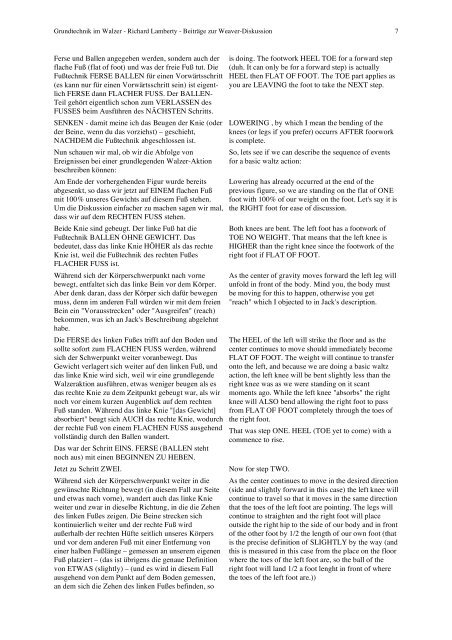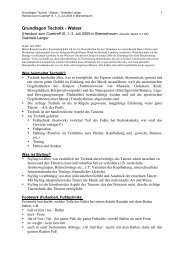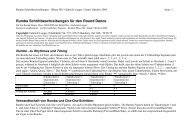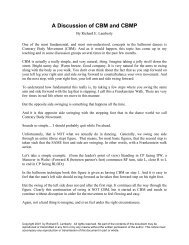Grundtechnik im Walzer - Richard Lamberty
Grundtechnik im Walzer - Richard Lamberty
Grundtechnik im Walzer - Richard Lamberty
Erfolgreiche ePaper selbst erstellen
Machen Sie aus Ihren PDF Publikationen ein blätterbares Flipbook mit unserer einzigartigen Google optimierten e-Paper Software.
<strong>Grundtechnik</strong> <strong>im</strong> <strong>Walzer</strong> - <strong>Richard</strong> <strong>Lamberty</strong> - Beiträge zur Weaver-Diskussion 7<br />
Ferse und Ballen angegeben werden, sondern auch der<br />
flache Fuß (flat of foot) und was der freie Fuß tut. Die<br />
Fußtechnik FERSE BALLEN für einen Vorwärtsschritt<br />
(es kann nur für einen Vorwärtsschritt sein) ist eigentlich<br />
FERSE dann FLACHER FUSS. Der BALLEN-<br />
Teil gehört eigentlich schon zum VERLASSEN des<br />
FUSSES be<strong>im</strong> Ausführen des NÄCHSTEN Schritts.<br />
SENKEN - damit meine ich das Beugen der Knie (oder<br />
der Beine, wenn du das vorziehst) – geschieht,<br />
NACHDEM die Fußtechnik abgeschlossen ist.<br />
Nun schauen wir mal, ob wir die Abfolge von<br />
Ereignissen bei einer grundlegenden <strong>Walzer</strong>-Aktion<br />
beschreiben können:<br />
Am Ende der vorhergehenden Figur wurde bereits<br />
abgesenkt, so dass wir jetzt auf EINEM flachen Fuß<br />
mit 100 % unseres Gewichts auf diesem Fuß stehen.<br />
Um die Diskussion einfacher zu machen sagen wir mal,<br />
dass wir auf dem RECHTEN FUSS stehen.<br />
Beide Knie sind gebeugt. Der linke Fuß hat die<br />
Fußtechnik BALLEN OHNE GEWICHT. Das<br />
bedeutet, dass das linke Knie HÖHER als das rechte<br />
Knie ist, weil die Fußtechnik des rechten Fußes<br />
FLACHER FUSS ist.<br />
Während sich der Körperschwerpunkt nach vorne<br />
bewegt, entfaltet sich das linke Bein vor dem Körper.<br />
Aber denk daran, dass der Körper sich dafür bewegen<br />
muss, denn <strong>im</strong> anderen Fall würden wir mit dem freien<br />
Bein ein "Vorausstrecken" oder "Ausgreifen" (reach)<br />
bekommen, was ich an Jack's Beschreibung abgelehnt<br />
habe.<br />
Die FERSE des linken Fußes trifft auf den Boden und<br />
sollte sofort zum FLACHEN FUSS werden, während<br />
sich der Schwerpunkt weiter voranbewegt. Das<br />
Gewicht verlagert sich weiter auf den linken Fuß, und<br />
das linke Knie wird sich, weil wir eine grundlegende<br />
<strong>Walzer</strong>aktion ausführen, etwas weniger beugen als es<br />
das rechte Knie zu dem Zeitpunkt gebeugt war, als wir<br />
noch vor einem kurzen Augenblick auf dem rechten<br />
Fuß standen. Während das linke Knie "[das Gewicht]<br />
absorbiert" beugt sich AUCH das rechte Knie, wodurch<br />
der rechte Fuß von einem FLACHEN FUSS ausgehend<br />
vollständig durch den Ballen wandert.<br />
Das war der Schritt EINS. FERSE (BALLEN steht<br />
noch aus) mit einen BEGINNEN ZU HEBEN.<br />
Jetzt zu Schritt ZWEI.<br />
Während sich der Körperschwerpunkt weiter in die<br />
gewünschte Richtung bewegt (in diesem Fall zur Seite<br />
und etwas nach vorne), wandert auch das linke Knie<br />
weiter und zwar in dieselbe Richtung, in die die Zehen<br />
des linken Fußes zeigen. Die Beine strecken sich<br />
kontinuierlich weiter und der rechte Fuß wird<br />
außerhalb der rechten Hüfte seitlich unseres Körpers<br />
und vor dem anderen Fuß mit einer Entfernung von<br />
einer halben Fußlänge – gemessen an unserem eigenen<br />
Fuß platziert – (das ist übrigens die genaue Definition<br />
von ETWAS (slightly) – (und es wird in diesem Fall<br />
ausgehend von dem Punkt auf dem Boden gemessen,<br />
an dem sich die Zehen des linken Fußes befinden, so<br />
is doing. The footwork HEEL TOE for a forward step<br />
(duh. It can only be for a forward step) is actually<br />
HEEL then FLAT OF FOOT. The TOE part applies as<br />
you are LEAVING the foot to take the NEXT step.<br />
LOWERING , by which I mean the bending of the<br />
knees (or legs if you prefer) occurrs AFTER foorwork<br />
is complete.<br />
So, lets see if we can describe the sequence of events<br />
for a basic waltz action:<br />
Lowering has already occurred at the end of the<br />
previous figure, so we are standing on the flat of ONE<br />
foot with 100% of our weight on the foot. Let's say it is<br />
the RIGHT foot for ease of discussion.<br />
Both knees are bent. The left foot has a footwork of<br />
TOE NO WEIGHT. That means that the left knee is<br />
HIGHER than the right knee since the footwork of the<br />
right foot if FLAT OF FOOT.<br />
As the center of gravity moves forward the left leg will<br />
unfold in front of the body. Mind you, the body must<br />
be moving for this to happen, otherwise you get<br />
"reach" which I objected to in Jack's description.<br />
The HEEL of the left will strike the floor and as the<br />
center continues to move should <strong>im</strong>mediately become<br />
FLAT OF FOOT. The weight will continue to transfer<br />
onto the left, and because we are doing a basic waltz<br />
action, the left knee will be bent slightly less than the<br />
right knee was as we were standing on it scant<br />
moments ago. While the left knee "absorbs" the right<br />
knee will ALSO bend allowing the right foot to pass<br />
from FLAT OF FOOT completely through the toes of<br />
the right foot.<br />
That was step ONE. HEEL (TOE yet to come) with a<br />
commence to rise.<br />
Now for step TWO.<br />
As the center continues to move in the desired direction<br />
(side and slightly forward in this case) the left knee will<br />
continue to travel so that it moves in the same direction<br />
that the toes of the left foot are pointing. The legs will<br />
continue to straighten and the right foot will place<br />
outside the right hip to the side of our body and in front<br />
of the other foot by 1/2 the length of our own foot (that<br />
is the precise definition of SLIGHTLY by the way (and<br />
this is measured in this case from the place on the floor<br />
where the toes of the left foot are, so the ball of the<br />
right foot will land 1/2 a foot lenght in front of where<br />
the toes of the left foot are.))






